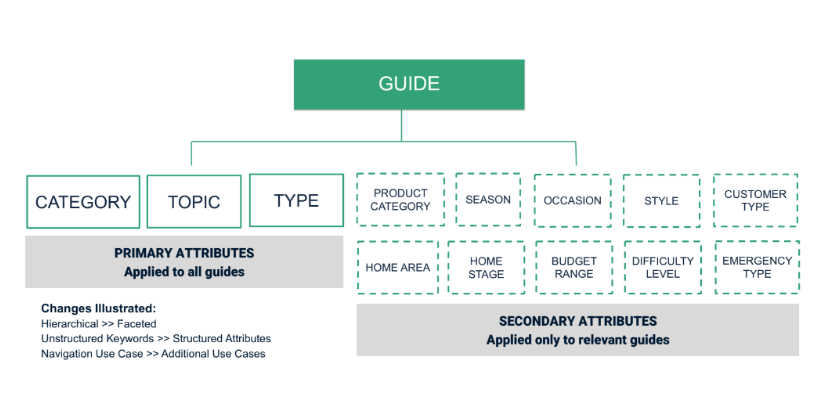
When you create a well-structured content taxonomy, your users and customers will be able to find the content they want and need more easily. But deciding how to organize your content takes time and forethought. It helps to think through your objectives, goals, approach, and processes for testing and maintaining your content taxonomy.
This article walks through how to design and implement a content taxonomy, and what to consider along the way.
Key Steps to Start Creating a Content Taxonomy
When tackling taxonomy, there are four essential steps to follow.
1. Align
Purpose: The first step is to align key stakeholders around the purpose of creating a taxonomy. For example, you might aspire to offer better personalized suggestions or recommendations. Or you may want to improve the organization of your digital assets to make them easier to find.
Benefits: It also helps to consider what benefits you hope to gain by creating a taxonomy for your content. A common benefit is improved search visibility to increase traffic from external sources. You can achieve this by adding internal filters (tags) to help users drill deeper into content through site search, or through better navigation and browsing. And a good taxonomy can also enable more efficient reporting on your content effectiveness.
2. Define
Once you and your stakeholders are aligned on objectives, it is time to begin drafting your content taxonomy. As you begin this task, you should consider using:
- Content models: How granular is your content? Article level? Module / component level?
- A content audit and map: What content has potential for reuse? For personalization?
- Customer models: What is the user / customer journey? What are the priority segments / cohorts? What are the opportune moments?
Common taxonomy types include:
- List: Collection of terms
- Tree: Clusters of lists
- Hierarchy and Polyhierarchy: Tree with strict rules
- Facet system: Clearly defined attributes; in some ways this combines all of the other three taxonomy types
When you know what type of taxonomy you need, you can start to define attributes that connect content in ways that build amazing experiences, and ultimately connect customers with the right content.
If your content volume is low, a simple approach will probably work for you. If you have a lot of content, you will likely need a faceted system.
We find that in most cases, a strict hierarchy is unnecessary and a flatter approach works well. Typically, we often recommend a faceted system.
Think of your content as a Lego brick. All the little knobs are the facets, or the attributes. The brick’s facets enable you to connect content together to build something greater, like a Millennium Falcon.
Here’s an example of an effective, streamlined faceted system.

When thinking about what attributes you might need in a taxonomy, remember the acronym, LATCH, coined by Richard Saul Wurman.
- Location: Geography is a common attribute that global companies with complex ecosystems use
- Alphabetical order: Resources like glossaries or directories may benefit from this type of display order
- Time: This could refer to date published, date announced, date reviewed, date updated, or any other defining dates relevant to a piece of content
- Category: This is the most flexible element that you’ll need to define. Categories could be department, product, customer, format, or topic categories, for example
- Hierarchy: Hierarchy can relate to strict levels of content, however, thinking in terms of priority can be more useful. What’s popular? What are the editor’s picks? What content is most frequently inquired about? What’s in demand? What’s in season? Consider common priorities that can bring definition to your content taxonomy
3. Refine
You should always test out your draft content taxonomy approach. It’s helpful to create a quick mockup, or even a live, small scale pilot. This helps get everyone on the same page, and helps identify opportunities to refine and improve your taxonomy approach even further.
Start by testing or piloting the most common use cases. Also, test the boundaries, and think about the scenarios that would be the most complicated to implement. For example, what if an attribute doesn’t have many results? And on the other hand, what if it has hundreds?
Consider whether to test variations of the impact of the taxonomy on the user interface (e.g. different UIs for search filters) and variations of attribute labels and terminology. In other words, experimenting with design and with wording. There can be value in working with designers or content strategists to help you play this out.
4. Consign
To make your content taxonomy a reality you have to commit to implementing it with the right technology, roles, and processes. Consider drafting a roadmap for implementing your taxonomy. Whether it’s an update to an existing taxonomy, or a brand new taxonomy, you need to think through:
- Launch: What needs to happen to build? To launch? Who needs to be involved?
- Maintenance: How will you ensure content is tagged consistently? How will you handle requests for changes or additions?
- Evaluation and refinement: How will you track whether the taxonomy is working well? How will you identify opportunities to optimize?
Make consistency easy, and inconsistency hard. This could involve very clearly documenting attributes and the tags within each attribute (controlled vocabulary). It could include training content managers / contributors / designers in day-to-day tagging of attributes. Or using technology to automate tagging, or at least providing default options to reduce the manual load on individuals.
It’s also a good idea to set up a SOP (standard operating procedure) for requesting changes to taxonomy attributes or tags. Taxonomy is a living thing. Evolution is inevitable. Plan for it so you’re prepared. Keeping up with maintaining your taxonomy will help to future-proof it.
When it comes to evaluation, think back to your objectives, then ask questions that data can help you answer. Is organic traffic increasing? Are users clicking on the search filters or personalized recommendations? These are just some ideas for measures you can look at to track the impact of taxonomy changes.
Moving Forward
Now that you have an understanding of the practical steps involved in how to create a content taxonomy, you’re ready to take the next steps. Here are some suggestions for how to go from idea to full implementation with help from Content Science:
Dig in deeper with a certification course: This article features content from Content Science’s Content Engineering Certification program, which is part of our Content Science Academy. The certification course provides an introduction to content engineering, and covers topics including content management systems, content modeling, taxonomy + tagging, automation, personalization, and more.
Get guidance from our resource center. Explore our resource center for creating a winning taxonomy. You can use these materials to help you put together a strategy that works for your organization.
Partner with Content Science: We are here to help you. If your organization is ready to get to work developing and implementing a robust content taxonomy, you can engage Content Science to work with you and your team.
This article is part of our ongoing How To series, in which we help you learn how to get started in or improve across key content areas. Catch up with more in this series:
Events, Resources, + More
New Data: Content Ops + AI
Get the latest report from the world's largest study of content operations. Benchmarks, success factors, commentary, + more!
The Ultimate Guide to End-to-End Content
Discover why + how an end-to-end approach is critical in the age of AI with this comprehensive white paper.
The Content Advantage Book
The much-anticipated third edition of the highly rated book by Colleen Jones is available at book retailers worldwide. Learn more!
20 Signs of a Content Problem in a High-Stakes Initiative
Use this white paper to diagnose the problem so you can achieve the right solution faster.






Comments
We invite you to share your perspective in a constructive way. To comment, please sign in or register. Our moderating team will review all comments and may edit them for clarity. Our team also may delete comments that are off-topic or disrespectful. All postings become the property of
Content Science Review.